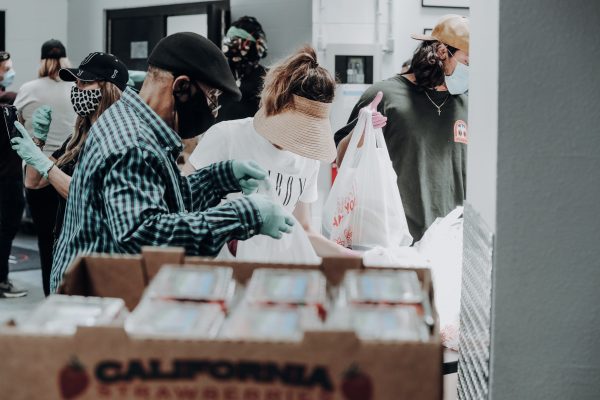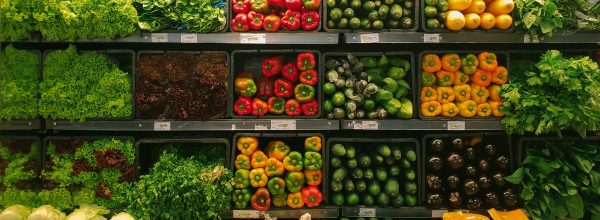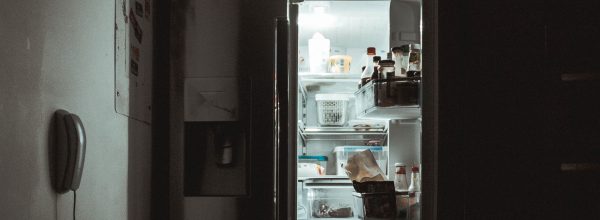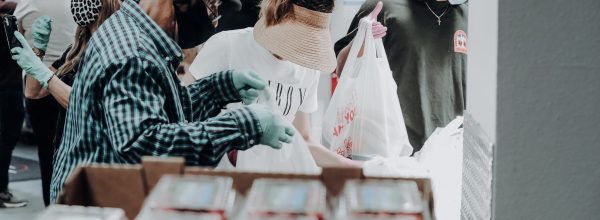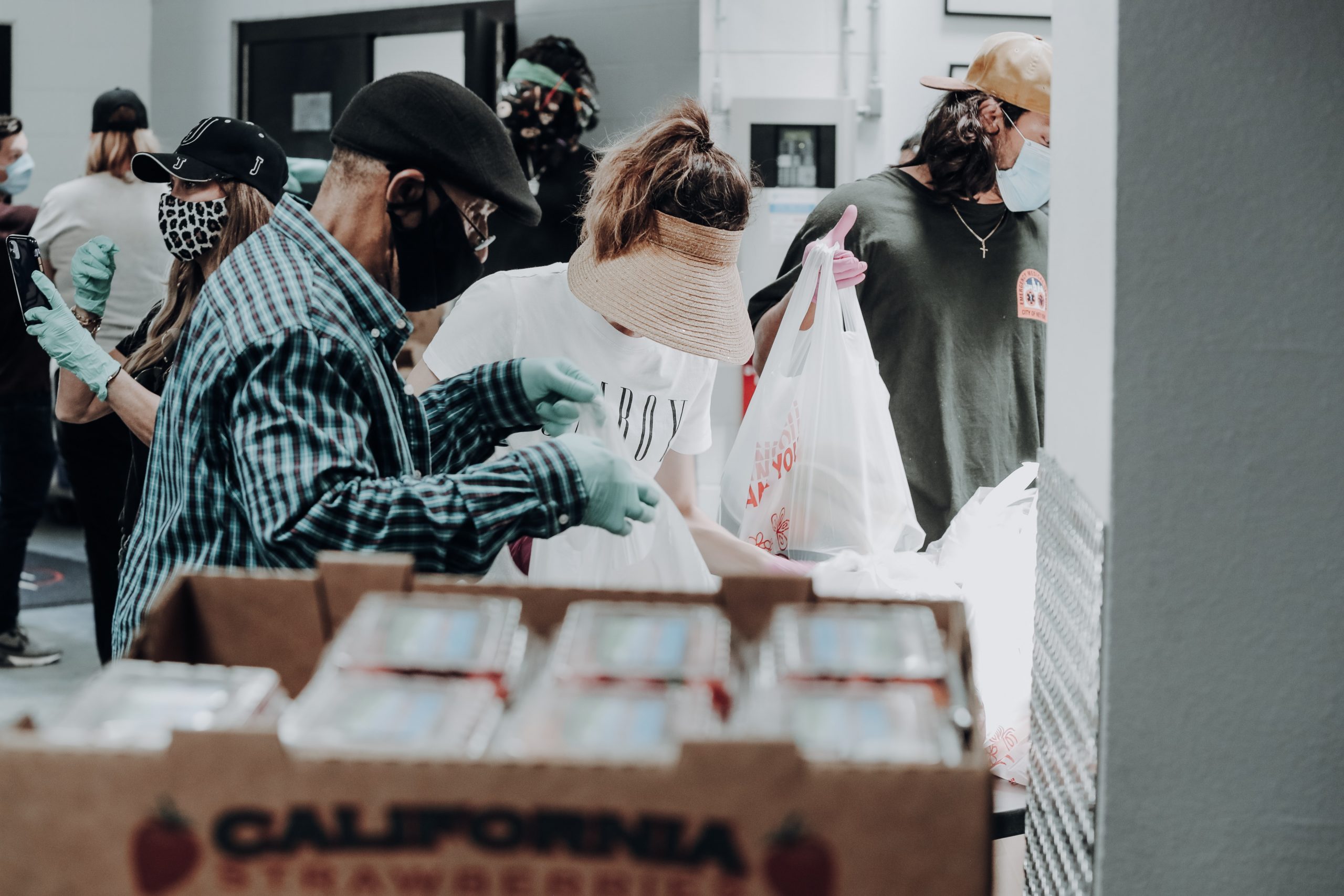
In the face of crushing need, the coronavirus pandemic has pushed safety net clinics to get creative when it comes to helping food insecure patients. Some might call it outside-the-box thinking — except for one Los Angeles clinic that sent many boxes of produce directly to hungry patients’ doors.
Like most clinics, Altamed Health Services Corporation (in partnership with Children’s Hospital of Los Angeles), had to pivot when patients stopped coming in for routine health care because of shelter-in-place mandates. To reach patients in need, AltaMed/CHLA mailed around 60 $20 grocery store gift cards to families identified as food insecure as part of an outreach program operating through two clinic sites, at CHLA and Westlake. Another COVID-19 workaround: Behavioral health case manager Cecilia Ramos handed out two dozen or so gift cards — until she ran out — to food insecure patients who participated in a drive-through immunization program run by the clinic during the quarantine. The grocery gift card initiative dispersed around 150 cards. Patients preferred cards from Food 4 Less because they already shopped at the store and it was close to where they lived, says Ramos.
AltaMed/CHLA also began contracting with Imperfect Foods, as part of a pilot program — scheduled to be expanded — to help 10 families with low food security. Imperfect Foods, as its name suggests, delivers less-than-pristine-looking produce and other groceries to people’s homes.
These are just a few ways participants in Moving Clinics Upstream, a CCI program funded by Cedars-Sinai, have responded to the pandemic, which has seen food insecurity skyrocket due to record unemployment as a result of the three-month-long quarantine. Moving Clinics Upstream was designed to address two top patient health concerns, food insecurity and transportation, by going beyond the walls of these federally-funded safety net health centers. Six Los Angeles clinics —AltaMed, APLA Health, Behavioral Health Services, Eisner Health, Los Angeles LGBT Center, and St. John’s Well Child & Family Center — are part of the Moving Clinics Upstream food insecurity cohort.
Perhaps the biggest adaptation for all community clinics as a result of the crisis is a rapid ramping up of telephone and telehealth services in place of in-office visits. Health clinics are using a diverse list of telemedicine services — including eClinicalWorks/healow, Jive GoToConnect, Skype, WhatsApp and Zoom — to conduct virtual visits. “We’ve had to get more creative with how we connect with patients,” says Amanda Daigle, project manager, general pediatrics at CHLA. “There have been significant efforts to improve and expand telemedicine pretty rapidly, but that comes with challenges around screening for food security as the typical workflow has been altered.”
Daigle explains that with in-office visits, medical assistants screen every patient for food insecurity before handing them off to a physician. “Our medical assistants have all been trained in how to do this,” adds Daigle. The clinics screen patients for food insecurity, using the Hunger Vital Sign, a two-question food insecurity screening tool developed by the Nutrition and Obesity Network. “But during the pandemic, we have patient visits via phone, video, and drive-through. We encourage all our physicians to ask about food security; some are better at it than others.” Clinic staff are also aware that it can be awkward or uncomfortable for patients to answer these questions via telehealth, when it’s unclear who is in the room on either end. “There have been a lot of adjustments in the last few months — we’ve gone from 0 to 60 with telehealth,” says Daigle. “So it’s to be expected that workflows have been impacted.”
Thinking Outside the Box, With a Box
AltaMed Health Services runs a network of more than two dozen clinics in L.A. and Orange counties. It is one of the nation’s largest community health centers, typically serving more than 300,000 patients annually.
Back in February, AltaMed/CHLA staff organized weekly grocery store delivery of $30 for families identified as very low food security, as part of what’s known as its Food Resources for Kids (FORK) program. When COVID-19 struck, that particular effort proved unreliable: Orders would get cancelled due to food shortages or delivery issues. So In early April, the team decided to switch to delivery service via Imperfect Foods. Food insecure families received produce delivery on a weekly basis. The effort was funded by AltaMed Gives, an internal AltaMed department that collects employee money for different causes and funds patients’ needs. AltaMed Gives contributions have also been used to put packaged food kits together for homebound senior citizens in Commerce during the pandemic.
“We were skeptical about using Imperfect Foods when the project launched because we thought families might not be as open to receiving ‘imperfect’ or ‘ugly’ produce,” says AltaMed project coordinator Joanna Garcia. “We wanted our patients to feel they were receiving quality produce — not that Imperfect Foods didn’t have quality produce — we just didn’t know how families might react to a box of funky looking fruits and vegetables.” But it’s been a positive, valuable, and convenient option for families, Garcia says. “I’ve been fielding calls from people that heard about the program and want to enroll, so we’re figuring out how we can expand the program and serve more families.” Adds Ramos: “In the rare instance when a patient didn’t know how to cook a vegetable — eggplant comes to mind — I would just talk them through it or send them a recipe.”
Imperfect Foods, a for-profit business, formerly known as Imperfect Produce, offers a reduced cost grocery box to anyone who qualifies for the federal Supplemental Nutrition Assistance Program (SNAP, formerly known as food stamps, and called CalFresh in the Golden State). The company offers a 33 percent discount off an order at checkout for SNAP recipients. During the shutdown, the company also offered free delivery for low-income seniors. Imperfect Foods came up with the reduced cost box idea as a workaround because prior to COVID-19, few SNAP recipients or EBT (electronic transfer benefit) users could use their benefits for online grocery ordering. The United States Department of Agriculture is currently running a pilot program to test online benefit use with large grocery chains. In late April, CalFresh expedited online ordering at Amazon and WalMart in response to the coronavirus.
For AltaMed/CHLA’s pilot program, recipients received boxes free of charge. Finding a good grocery match is not just about affordability. “We also wanted to be mindful of having produce that was culturally appropriate for families,” adds Garcia. AltaMed/CHLA has a large Latino patient population. In this case, the team picked the most basic produce box for patients and managed the online ordering — for ease and convenience. If customizing a box on their own, customers can choose from a wide range of seasonal fruits and vegetables along with a select number of pantry items including rice, oil, and cereal. Team members report that patients were impressed with the freshness of the produce but missed being able to purchase shelf-stable pantry items such as rice and beans, along with perishable protein such as milk, eggs, chicken, and other meat.
It took a little fancy dancing to match the clinics’ needs with the grocery program’s platform. Garcia explains: “I contacted Imperfect Foods and asked if we could have one account with multiple delivery addresses. But their system isn’t able to handle that, so Amanda, Cecilia, and I created 10 separate emails and split the families amongst ourselves to manage the deliveries.” The team wanted to remove any barriers that might prevent patients from getting the food they needed. “While our patients might benefit from more agency in the process — choosing their own food — we wanted to eliminate any obstacle to service, including lack of access to online data or Wi-Fi,” Daigle explains.
Unsurprisingly, the clinic saw a spike in families screening positive for food insecurity during the pandemic. In January 2020, 30 patients tested positive for food insecurity. In April that figure jumped to 44. Since tracking of food insecure patients began back in November, almost every patient who screened positive was connected to food support services, including enrollment in CalFresh and WIC (the Special Supplemental Nutrition Program for Women, Infants, and Children), food bank/pantry referrals, and grocery store gift cards. And all patients who screened positive received a three-month follow-up with Ramos, the case management social worker.
Indicative of just how challenging and chronic food insecurity is: every patient who was reached for follow-up screened positive for food insecurity, despite these interventions. “We weren’t surprised, a $20 gift card can help in the moment to meet critical needs — like milk for babies and a few days of meals but it’s not a sustainable solution,” says Ramos. Patients reported that food banks they could access had little fresh food or that most food had reached its use-by date. The clinic initially had a goal of a negative food insecurity screening for 75 percent of patients at the three-month post-intervention mark. That said, all team members concede that was a wildly optimistic goal, made all the more unattainable once COVID-19 and widespread unemployment hit. Says Ramos: “In our next cohort, if we can sustain the weekly food boxes and include pantry staples and fresh protein in the mix, then I think we might see a dramatic change.”
Another goal that was a stretch: AltaMed/CHLA had planned to screen 75 percent of its Westlake clinic patients for food insecurity. But data gathered to date suggests that figure is under 5 percent. Ramos and the rest of the team believe that figure isn’t truly reflective of how many patients are being screened but instead partly reflects a lack of reporting infrastructure, since corrected, to ensure that each screening is documented in patients’ electronic files.
“We hope to be able to continue FORK in some fashion and expand it to better serve our patients and their families in a way that makes sense in this ‘new normal’” says Garcia. “Our participants are so grateful for the help.”
View this post on Instagram
Growing Need for Sustainable Interventions
Food insecurity was already a significant problem for Los Angeles residents before the coronavirus pandemic, with 1 in 5 lacking access to enough food. Now, with more than half of all Angelenos unemployed and a staggering jump in homelessness before the virus even hit, Southern California food banks have been overwhelmed with demand and school sites are serving as de facto drive-through food pantries, feeding entire families. Eisner Health case worker Felix Dominguez reports helping connect patients accessing these grab-and-go meals from the same school so they can coordinate pickups. That’s especially useful, he says, for patients who are immunocompromised, as well as those without childcare or transport, and essential workers, who may have difficulty getting to the scheduled food pickups.
The scale of this pandemic-induced tsunami of hungry residents is massive: Tens of thousands of people, millions of meals. For example, in just one day, at one site, more than 26,000 gallons of milk, 219,000 cereal boxes, 27,525 pounds of carrots, 50 tons of fruit, and countless turkey sausages were distributed, according to the Los Angeles Times.
The Families First Coronavirus Response Act includes certain protections for benefit recipients enrolled in SNAP. Still, food insecurity remains a pressing concern for families who were already struggling before the virus, unemployment, and civil unrest. Many laid off or furloughed workers who frequent safety net clinics may not qualify for unemployment or stimulus payments from the federal government. Low-income families typically don’t have the resources to stockpile food. The Los Angeles Regional Food Bank has responded with contact-less drive through pick up and pop-up pantries. Some food banks, such as Second Harvest Food Bank in Orange County, are doing home deliveries for high-risk seniors and others.
How else to ensure that food insecure patients don’t go hungry?
For 30-plus years, APLA Health has had an on-site pantry program, which currently runs at eight clinic locations. The healthcare provider saw more than a 25 percent increase in demand for food when the virus first hit, according to Jeff Bailey, APLA Health’s director of HIV access and community-based services, of a program that pre-COVID fed around 1,700 low income residents a week. The clinic’s Vance North Necessities of Life Program provides essential food to clients — including meat, dairy, eggs, and fresh produce.
The program was set to expand March 1 — talk about timing — for the first time in its history. It now offers clients 100 percent of their weekly food needs: ingredients for 21 meals plus snacks. Funding for the increase in food came through Los Angeles County. The program provides almost 3,000 bags of groceries a week. APLA Health also offers clients Zoom nutrition classes and phone or web-based nutrition counseling. Begun as a $35-a-week food voucher program, it now serves as a model on-site feeding program. It is the country’s largest network of food pantries for people living with HIV/AIDS. “While vouchers are nice and perhaps clients/patients would prefer that, engaging with clients is important as it helps them remain connected to care and other services,” says Bailey. He points to the pop-up produce markets conducted by Northeast Valley Health Corporation (NEVHC), a Federally Qualified Health Center in Sylmar, in partnership with Cal Fresh Healthy Living, as another on-site effort that connects patients to food and healthcare in one convenient location.
NEVHC’s market, run by clinic staffers and patients volunteers, allows clients to choose food they’re familiar with and likely to eat and cook, which is both empowering to patients and helps prevent food waste.
In addition to home delivery, bringing food to the health-care setting — in the form of grocery bags or boxes, a pantry, or a pop-up produce market — is seen as a desirable option for patients who would be at the clinic anyway, work during food pantry hours, or don’t have childcare.
There are bureaucratic hurdles to jump through and liability concerns to consider but Daigle says CHLA is actively exploring an on-site food relief program for its patients. Given the food access difficulties created by both the coronavirus and vast unemployment, Garcia and Daigle say there is a newfound openness at their respective institutions in considering approaches to address this problem among its patient population. “There are challenges to implementing these kind of programs but I think CHLA will get there,” says Daigle. “We’re chipping away at the concerns. I’m optimistic we’ll have an on-site program down the track.” Adds Ramos: “When I refer my food insecure patients to a food bank, I don’t know if they’re able to get there. An on-site program would remove so many barriers and makes so much sense for our patients.”

